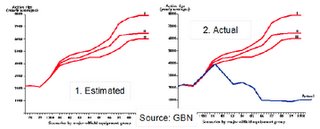 The National Intelligence Council, a division of the US CIA, conducts studies of future trends, the latest of which is called Mapping the Global Future and was published in December 2004.
The National Intelligence Council, a division of the US CIA, conducts studies of future trends, the latest of which is called Mapping the Global Future and was published in December 2004.
The report is a comprehensive effort by several hundred futurists offering four possible states of the world in 2020, mainly using the Scenario Planning methodology developed by the Global Business Network (GBN).
The point of scenario planning is to account for discontinuities that linear extrapolations of forecasting from the present cannot capture as demonstrated by GBN’s famous charts showing oil output 1980-1990 Figure 1. Estimated and Figure 2. Actual.
Mapping the Global Future is useful, in more than the Shirky-esque sense of not having similar alternatives, but is probably not broad enough to encompass the true future. Despite the National Intelligence Council’s use of scenario planning, many of the key issues articulated for 2020 are the same as those of today (the linear extrapolation fallacy of forecasting).
The study’s focus is broad with an emphasis on politics and military power. Consideration of the role of technology is particularly inadequate and uniformed given the accelerating pace of innovation and adoption and the heavily discontinuous aspects of technology. Security threats are discussed but not that the biggest ones in 2020 may be technological security risks. The scenarios are supposed to sound unlikely but possible; the scenarios presented in the study sound too shortsighted and obvious.
Some specifics from the study that do not quite resonate are that first, the study suggests that
Second, the study suggests that ethical issues such as Muslim/Western values cleavage and an important medical issue of today, HIV/AIDS, will still be at the forefront in 2020. This again seems superficial and may or may not be so, but should have more extensive supporting analysis. Ethnic friction and AIDS do not even seem to be a linear extrapolation of today but just status quo.
Third, the study's prognosticated marginal improvement in the condition of women in 2020 ignores the discontinuous sociological shifts cultures have experienced regarding economic wealth, fertility decisions and non-traditional family structure as education and work force access increases; even if women may be competing unfavorably for jobs in youth bulge cultures, they will be utilized in senior bulge cultures.
One of the study's most interesting projections, though under-highlighted and under-expanded, is that connectivity (e.g.; the connectiveness of the Internet, technology and the global economy) strains nationstates in 2020. Strains is probably a light word for how connectivity will have acted on the nationstate by 2020, depending on amongst other factors, how directly commercial interests pay for and administer their policing and security. The bifurcation between the globalized tech savvy creative class and everyone else bears more consideration on future politics, the issue being that not all power bases in the “everyone else” category can or will be integrated into the world economy.
Detailed Scenarios from the Mapping the Global Future study:
The study envisions four possible states of the future world, mainly concerning static political domination (again no consideration for quasi-discontinuities like dynamic cyber-communities with rotating issues influence as a function of voting support and expertise): Davos World (China and India non-Westerners dominate the leadership and participation in the world economy), Pax Americana (US still in hegemonic world political, economic and technological control), A New Caliphate (radical Muslim religious identity politics with anti-Western ethics dominate the world) and the Cycle of Fear (Orwellian world of fear and security, presence of bio/other terrorism, nuclear proliferation dominate the world).



































 Email me
Email me Twitter
Twitter MS Futures Group
MS Futures Group Data Visualization Wiki
Data Visualization Wiki Economic Fallacies
Economic Fallacies
